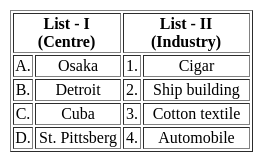MH SET Paper 2 Mock Test - 2 (Geography) - MAHA TET MCQ
30 Questions MCQ Test MH SET Mock Test Series 2025 - MH SET Paper 2 Mock Test - 2 (Geography)
The Concentric circle theory of city morphology was developed by:
Which of the following is not a part of Social Geography?
Heritage power project Sonapani mini-hydel power project is located in which state?
In which stage of landscape evolution do relief features become more subdued?
What is the primary driving force behind the cycle of erosion theory?
Match List - I with List - II and select the correct answer from the code given below the lists.

(a) The industrial region of Mumbai-Pune flourished due to the development of cotton textile industry.
(b) The Kollam-Thiruvanathapuram industrial region has agricultural processing and market-oriented light industries.
(c) Chotanagpur industrial region is called Ruhr of India.
(d) The Gurgaon-Delhi-Meerut industrial region is famous from heavy industries.
Consider the following statements regarding Geothermal Energy:
1. Generated due to Radioactive decay of the material inside the surface of the Earth.
2. India does not contribute in its production due to its location near the Himalayas.
Which of the statements given above is/are correct?
Which of the following is/are the 'push factor' affecting migration?
(A) Better opportunities for work
(B) Better health facilities
(C) Poorer health facilities
(D) Absence of good educational institution
Choose the correct option.
Assertion (A): The temperature increases in the stratosphere.
Reason (R) : The boundary between stratosphere and mesosphere is called as stratopause.
Select the correct answer from options given below:
In India which age group is considered as economically productive?
i. Goods have high demand with low prices.
ii. The demand curve rotated round the production point to give shape.
iii. As the competition increases, the market areas becomes hexagonal.
a. Flow maps tell us what is flowing or being migrated
b. It tells us about the direction of the movement
c. Flow maps give a general information about what is flowing and how it is flowing
d. Flow maps also tell us about the speed at which the flow occurs.
Which of the above statements are correct?
In India which age group is considered as economically productive?
After which one of the following tribes of India has a supercontinent of ancient geological history of the world been named?
For cotton cultivation which among the following soils is considered most suitable?
Solifluction is a geomorphic process involving a special type of soil flow that is noticed in
Which metal is the most abundant in the earth crust?
Which of the following statement is correct about weathering?
a) Sea level Changes are only affected by Eustatic changes.
b) Marine sediments depict about global sea level change.
c) Evidences of sedimentary deposits of various sorts depict sea level changes during the pre-quaternary stages.
d) Sea level has risen by about 10 to 16 cm in the past 100 years.
Which of the following statements is correct?
In an ecotone, the species which become abundant are called:
|
60 tests
|














